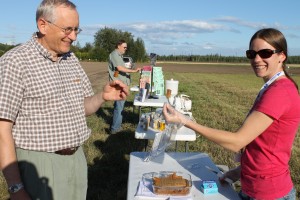Yes, you can grow grain in Alaska’s Interior
September 17, 2012
907-474-5042
9/10/12
On a beautiful August evening, more than people showed up at a grain growing workshop held at the Fairbanks Experiment Farm, testament to the fact that there is definitely interest in growing barley and oats in the Far North.

Bob Van Veldhuizen, research technician at the University of Alaska Fairbanks School of Natural Resources and Agricultural Sciences, told the crowd that when he first started working at the farm everything was done by hand. “We planted, maintained, harvested, dried, threshed and cleaned the seeds by hand,” Van Veldhuizen said.
He assured the attendees that growing grains on a small scale can be done the old-fashioned way. “A small combine costs $250,000 and a thresher $25,000,” he said, emphasizing the impracticality of gardeners purchasing such equipment.
For a 180-square foot plot, Van Veldhuizen plants a half-pound of seed, which is very easy to do. “It only takes 15 minutes,” he said. “To harvest takes a couple of hours.”
The yield depends on the weather, soil and location. Growers need a good seed bed and the seeds should be planted one to one and a half inches deep, then the soil must be sealed around the seed. “Moisture is key to a good planting,” Van Veldhuizen said.
Choosing the right variety is also crucial. “That’s the reason we do variety trials so you guys don’t have to,” Van Veldhuizen said. He worked on the development of Sunshine Barley for years and it has proven very popular with growers due to its hulless nature.

As sandhill cranes flew over, Van Veldhuizen said they are notorious for harvesting the grains before he can get to it. “And moose and grizzly bears love the oats,” he said.
Alaska seeds can be purchased from the Division of Agriculture’s Plant Materials Center in Palmer. A 50-pound bag is around $85.
Seeds can be frozen or kept in a burlap sack but they will lose their germination ability over time. “You must keep squirrels and voles out,” Van Veldhuizen cautioned.
He advises planting as early as possible in May. The latest he has planted is May 20. “I like to plant early, around May 10 or 12 if it’s dry enough to not get stuck.
“You can plant winter grains now and harvest in a year.” At least two feet of snow needs to cushion the seeds or they will rot. Winter grains will produce the same yields if nothing goes wrong. “I recommend spring planting,” Van Veldhuizen said.
He also likes row planting. “You could broadcast it but it’s a little more difficult to maintain.”
Then he turned to a topic dear to the hearts of growers—weeds. “It’s easy to maintain weeds beneath rows with a hoe but if you broadcast the seeds it is hard to weed.”
Grain seeds need temperatures of 40 or warmer to germinate but weeds can do so quicker, in about a week.
Wheat is difficult to grow in Alaska. “If there is a killing frost it’s done,” Van Veldhuizen said. “I’m lucky to get it to harvest once every five years; with barley we get it every year. Barley is just about always a success.”
Associate professor Mingchu Zhang addressed the subject of soil. “Chemical fertilizers are easy,” he said. “But if it’s on the surface it’s not efficient. Phosphate is hard to get into the soil.”
Fish waste is a wonderful solution. “If you bury it too deep it will hurt the plant roots but if it’s too shallow dogs will dig it up,” Zhang said. He suggested filling a five-gallon bucket with half fish waste and half soil. Let it sit till the next growing season. “Over the years you will build up soil fertility,” Zhang said.
UAF Cooperative Extension Service agent Steven Seefeldt, who hosted the event, said if growers plant the same thing year after year, diseases will come. “Planting wheat one year plays with the mind of fungi. It breaks the cycle,” he said.

Kate Idzorek, CES research kitchen coordinator, ended the evening explaining how to cook with barley. “You don’t have to go straight to flour,” she said. “You can use it in soups. You can pop it in air popcorn popper to make a really good snack.”
Barley flour is best for non-yeast baked goods such as banana bread, carrot cake and cornbread. “You can use 100 percent barley in quick breads. For yeast breads use only one-third barley flour.” Idzorek advised one-third barley flour, one-third whole wheat flour and one-third all-purpose flour. “You’ll be pretty happy,” she said.
For more information on growing grains, visit www.uaf.edu/snras and find “Growing Small Grains in Your Garden” in the publications list.
Barley recipes developed by UAF CES are available at http://www.uaf.edu/ces/pubs/catalog/detail/index.xml?id=488
CONTACT: Bob Van Veldhuizen, rmvanveldhuizen@alaska.edu. Steven Seefeldt, ssseefeldt@alaska.edu. Kate Idzorek, kjidzorek@alaska.edu. Mingchu Zhang, mzhang3@alaska.edu.
This column is provided as a service by the UAF School of Natural Resources and Agricultural Sciences and the Agricultural and Forestry Experiment Station. Nancy Tarnai is the school and station’s public information officer. She can be reached at ntarnai@alaska.edu.


